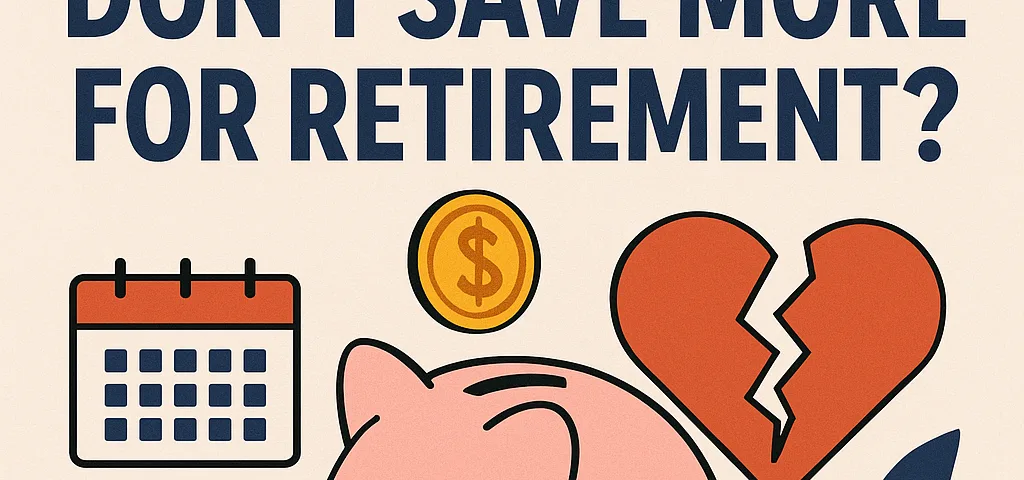Best Places to Travel in September: Easy Adventures & Deals
julio 19, 2025
Time Management Synonym: Smarter Ways to Say It
julio 19, 2025Updated: July 2025
Let’s Get Real: Saving Feels Harder Than It Should
What are two reasons Americans don‘t save more for retirement? We’ll get into the full answer in just a second, but here’s a hint: it’s not because people are lazy or don’t care. The reasons are surprisingly relatable and a bit frustrating. In fact, if you’ve ever looked at your bank account and thought, “Yeah, saving can wait,” you’re not alone.
In this blog, we’ll explore why so many people struggle with retirement saving, how societal habits influence our financial choices, and what you can actually do about it (without giving up coffee or canceling Netflix). We’re here to answer, in a lighthearted but clear way, the big question: what are two reasons Americans don‘t save more for retirement? And while we’re at it, we’ll throw in the three reasons to save money, common retirement myths, and practical saving tips to help you flip the script.
1. “Live for Today” Culture Is a Real Thing
Coffee now, crisis later?
One major reason Americans don‘t save more for retirement is our culture of instant gratification. We live in a world of one-click orders, same-day delivery, and YOLO spending. Saving for a distant future? That’s a hard sell when brunch with friends or a new phone upgrade is calling your name.
Social media doesn’t help either. Seeing everyone else living their best lives can make saving feel like a punishment. The idea of skipping a vacation to put money in a retirement account that won’t pay off for 30 years? Not exactly thrilling. But it matters.
2. Lack of Financial Education
Oops, I forgot to budget again.
Another big reason Americans don‘t save more for retirement is plain old lack of education. Many schools skip financial literacy entirely, and a shocking number of adults don’t know how compound interest works or what a Roth IRA even is.
It’s not that people don’t want to save. They often just don’t know how. Without clear guidance, saving feels overwhelming. So it gets pushed to the side, again and again.
The Three Reasons to Save Money Are… Because we know this is a question you might also be googling while reading, here’s the short version:
- Security: Emergencies, job loss, or unexpected expenses.
- Freedom: Want to travel, switch careers, or start a business?
- Retirement: So you don’t work until you’re 90 (unless you really want to).
These three reasons to save money are what financial planners call the “why” behind your wallet. And they’re all connected to the bigger question of what are two reasons Americans don‘t save more for retirement?
Let’s Talk About Paychecks, Debt & the American Dream
Why do people live paycheck to paycheck?
Another piece of the puzzle is that many Americans are simply stretched thin. Student loans, car payments, medical bills they all add up. Even folks with decent incomes often feel like there’s nothing left to save by the end of the month. It’s not that they’re unwilling to save. It’s that there’s genuinely no room in the budget.
When saving feels like a luxury, it becomes optional. And that’s dangerous.
Myth Buster: “Social Security Will Cover Me” Spoiler: Probably not.
Many Americans don‘t save more for retirement because they assume Social Security will take care of everything. Unfortunately, Social Security was never designed to be your full retirement income. It’s a supplement. Depending on it alone is like trying to run a marathon on a banana and a high five.
Coming Up Next:
- How to start saving for retirement with $50
- Retirement saving strategies that don’t feel like a punishment
- Why budgeting doesn’t have to be boring
- Real-life examples of people who turned things around
Stick with us, because the rest of this guide is about to make saving feel not only doable, but maybe even (dare we say it?) exciting.
How to Start Saving for Retirement With Just $50
Small start, big impact.
What are two reasons Americans don’t save more for retirement? A huge one is that many people believe they need a ton of money to even begin. But here’s the truth bomb: You don’t need a six-figure income or a Wall Street advisor to start saving for retirement. You just need $50 and a plan.
Start Where You Are
If you’ve got $50, you’ve got a head start. Open a Roth IRA (which is free with many brokerages), and set up a monthly auto-deposit even if it’s just $25. Apps like Acorns, Stash, or Fidelity Spire are beginner-friendly and allow micro-investing without needing a finance degree.
That first $50 might not seem like much, but here’s where compound interest enters the chat. Your money grows over time, and every dollar you contribute earns a little more. Over 30 years? That tiny seed could blossom into thousands.
Why Starting Early Beats Starting Big
When it comes to retirement, time matters more than size. Someone who starts saving $50/month at age 25 could retire with more money than someone who starts saving $500/month at 45. Why? Because early savers give their money more time to grow.
And that’s part of the answer to what are two reasons Americans don’t save more for retirement—many people underestimate the power of small, consistent steps and overestimate how much they need to get started.
Pro Tip: Make It Automatic
One of the easiest ways to stick with retirement saving is to set it and forget it. Automate your contributions. That way, saving happens before the money even hits your checking account. Out of sight, into savings.
Budgeting Doesn’t Have to Be a Buzzkill
Fun with funds? Yes, please.
Budgeting gets treated like the broccoli of personal finance good for you, but nobody’s thrilled about it. But here’s the twist: budgeting is actually one of your strongest tools for fighting off the two reasons Americans don’t save more for retirement impulse spending and lack of awareness.
Instead of thinking of budgeting as restrictive, think of it as empowering. A good budget doesn’t tell you what you can’t do it tells your money what it can do for you. It transforms the vague idea of “I should be saving more” into a clear, actionable plan.
Apps like YNAB (You Need A Budget), Goodbudget, and even your bank’s own budgeting tools help you track spending, plan ahead for bills, and carve out money for retirement savings without canceling everything that makes life enjoyable.
And yes, you can still have lattes. Just budget for them! It’s not about eliminating joy it’s about making sure that joy today doesn’t cost you peace of mind tomorrow. Budgeting makes saving feel less like a sacrifice and more like a smart, empowering choice. That shift in mindset could be exactly what helps Americans save more for retirement.
Simple Retirement Plans That Actually Work
Keep it real, and keep it consistent.
Let’s be honest one of the main reasons Americans don’t save more for retirement is that the whole concept feels intimidating. Index funds? Asset allocation? Retirement calculators? It’s enough to make anyone’s eyes glaze over.
But it doesn’t have to be that complicated.
Start simple: If your job offers a 401(k), enroll and contribute enough to get the full employer match. That’s literally free money think of it as a bonus for your future self. Don’t have access to one? Open a Roth IRA or traditional IRA. Many providers will walk you through it in minutes.
Not sure where to invest? A target-date fund does the heavy lifting. It automatically adjusts your investments based on your age and expected retirement year. No spreadsheets, no guesswork just consistent progress.
The golden rule here is consistency over perfection. Saving $100 every month beats waiting to invest $1,000 “someday.” Automation helps a lot too set up an auto-transfer so it happens without you even thinking about it.
So again, what are two reasons Americans don’t save more for retirement? Overcomplicating the process and assuming it takes thousands to start. But with these simple, smart retirement plans, you can kick both excuses to the curb.
Real-Life People Who Turned It Around
They did it. So can you.
Sometimes the best way to beat discouragement is to see proof that real people, just like you, have done it and thrived. What are two reasons Americans don’t save more for retirement? Often, it’s because they don’t see themselves in the stories of financial success. So let’s change that:
- Mike, 42 – The Late Bloomer with a Plan
Mike didn’t even think about retirement until age 37, when a podcast on compound interest sparked something. He opened a Roth IRA, set up auto-deposits of $150/month, and slowly watched it grow. Today, he has over $60,000 saved and even opened UTMA accounts for his kids to teach them early. His biggest takeaway? “I thought I was late. Turns out, I was just on time.” - Aisha, 29 – The Freelance Hustler Who Budgeted Her Way Up
As a self-employed designer, Aisha never had a traditional 401(k). But she didn’t let that stop her. She uses the 50/30/20 budgeting rule (50% needs, 30% wants, 20% savings), maxes out her Roth IRA yearly, and has built a $20,000 emergency fund. She also set up a SEP IRA to save even more. “I made my irregular income work for me,” she says. - Carlos & Jenna – The Debt-Ditching Duo
This couple graduated with six figures in student debt and no savings. Instead of panicking, they got strategic. They lived lean for three years, paid off $100k in loans, and redirected their $1,800 monthly loan payment straight into retirement savings. Now in their mid-30s, they’re sitting on a six-figure nest egg. “Every time we invest, we feel like we’re taking back time we lost.” - Lana, 51 – The Restart Queen
Divorced at 45 with barely $1,000 to her name, Lana knew she needed a financial reset. She got serious: read blogs, took a personal finance course, and opened a traditional IRA. She started side hustling Uber, tutoring, reselling online and socked away every extra dollar. Fast forward six years, and she’s saved over $75k. “I didn’t think it was possible at my age. But here I am.”
These stories prove that no matter your age, income, or past mistakes, it’s absolutely possible to turn your finances around. And if you’re wondering what are two reasons Americans don’t save more for retirement, maybe one of them is never hearing stories like these until now.
Final Thoughts: Flip the Script
Your future self will thank you.
So, what are two reasons Americans don’t save more for retirement? Instant gratification and financial illiteracy are the big ones. But here’s the truth: they’re not life sentences. With the right mindset and a few actionable habits, anyone can shift their financial future.
Saving isn’t about punishment or sacrifice it’s about choice, peace of mind, and long-term freedom. Whether you’re 21 or 51, the door to a secure retirement isn’t locked. You just need to walk through it. And no, it doesn’t require perfect budgeting or six-figure salaries. Just small, steady steps.
If you’ve made it this far, you’re already ahead of the curve. You’re asking the right questions. You’re learning. And that counts.
Frequently Asked Questions (FAQ)
1. What are two reasons Americans don’t save more for retirement?
The most common reasons are instant gratification (prioritizing present spending over future planning) and a lack of financial education (many people simply don’t know how or where to start).
2. How much should I save for retirement each month?
A general rule of thumb is 15% of your income, but even 5-10% is a great start especially if you begin early and increase gradually.
3. Can I start saving for retirement if I’m in debt?
Yes. You can contribute small amounts to retirement while tackling debt. Even $25 a month builds the habit and benefits from compounding.
4. Are budgeting apps really helpful?
Yes. Tools like YNAB, Mint, or Goodbudget help you see where your money goes and make intentional saving easier.
5. Is Social Security enough for retirement?
Nope. It’s meant to be a supplement, not your entire plan. Think of it as a backup, not a full solution.
6. Is it too late to start saving in my 40s or 50s?
Absolutely not. Start now, save aggressively, and consider working with a financial advisor to maximize catch-up contributions.
7. What’s the easiest retirement account to open?
A Roth IRA is often the most beginner-friendly and flexible option, especially if you don’t have a 401(k) through your job.
The bottom line? Start where you are. Use what you have. And don’t let fear or doubt keep you from a better financial future.. It’s about freedom. And the best time to start? Yesterday. The second-best? Right now.




